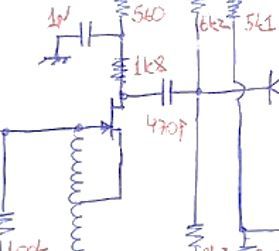Wideband VHF VCO

In this post we are going to take a look at a simple VCO I designed to accomplish a wide 2:1 tuning ratio, from 30 to 60MHz.
Te design is based on a JFET Hartley topology with a BJT buffer. The resonant tank is made tunable by a pair of back-to-back varactors. In this design I used two 1N5819 Schottky diodes as discussed here.

The core of this VCO is the JFET transistor. A JFET is useful in Hartley topologies because of the simplified bias scheme. The JFET is self-biased with the source - at DC - directly tied to ground by the inductor center tap.
The Hartley topology becomes interesting for wideband oscillators because it allows the varicap to be the unique source of negative reactance, as the feedback from source to gate is made by the inductive part of the tank. This increase the tuning band because the dominant capacitance is changed by the controlling voltage (think about it in contrast to a Colpitts topology, where the feedback is made with capacitors, adding constant capacitance to the tank).
The 100K resistor and 1N4148 diode helps control of the amplitude, by soft-clipping the tank energy. The back-to-back varactor pair is connected directly to the inductor, creating the parallel LC tank.
Output from the JFET is taken from the drain. It is common to take the output from the source, because the lower impedance and the cleaner signal, but I choose the drain to increase the isolation of the load from the tank, reducing load pulling effects.
A BJT Darlington pair buffer the signal to the output. To increase efficiency and to prevent current cut-off from the AC coupled output load, the pair is biased by the bottom BJT acting as current sink.
The two inductors are self-supporting coils of 5 mm diameter, 6 turns of 19AWG each. I placed them aligned to increase mutual coupling, acting as an air core auto-transformer. The coupling can be adjusted reducing or increasing the distance between the coils, changing the overall frequency band. This coupled inductor is part of the standard Harley oscillator, however uncoupled inductors had been tested and worked fine.
